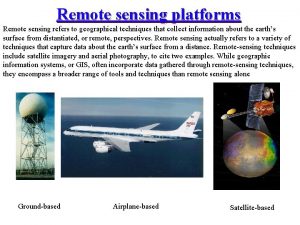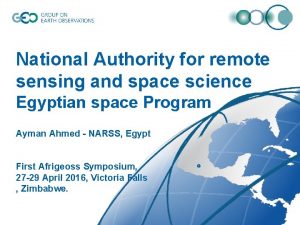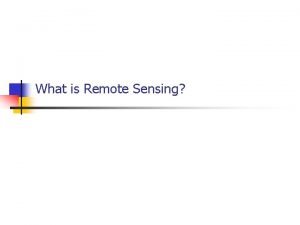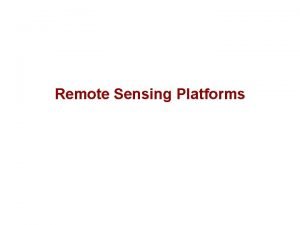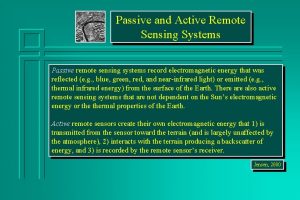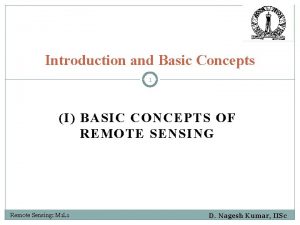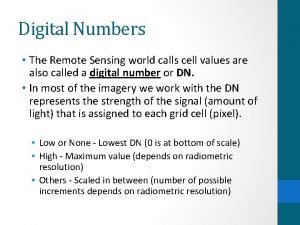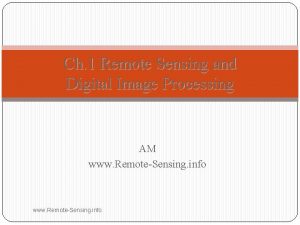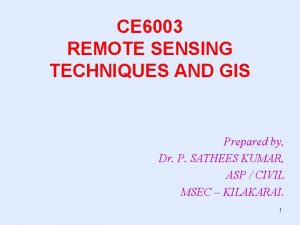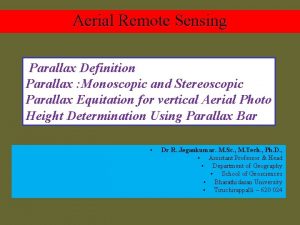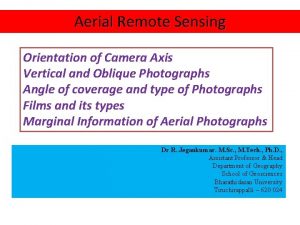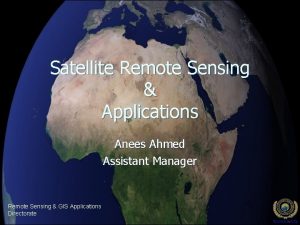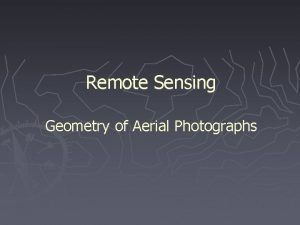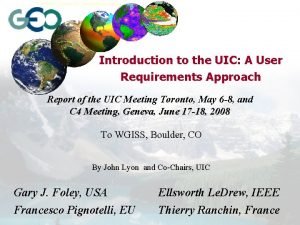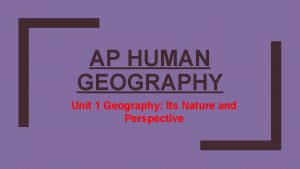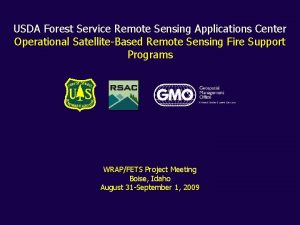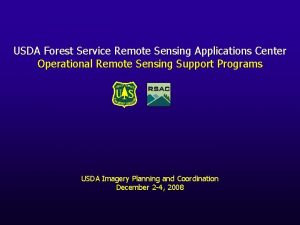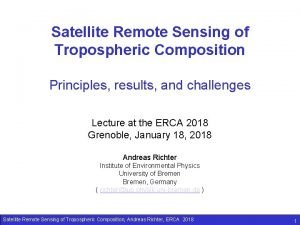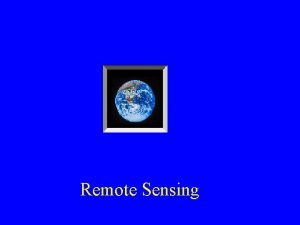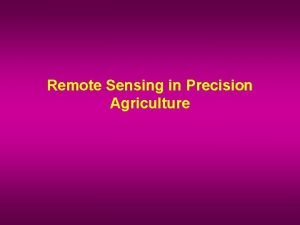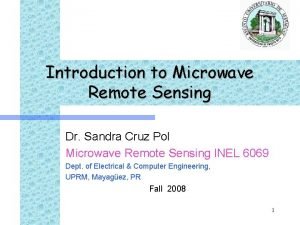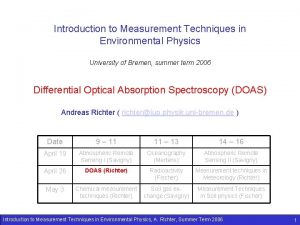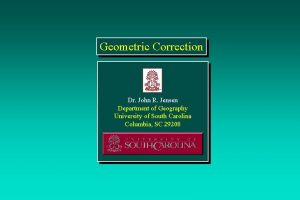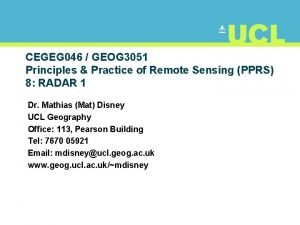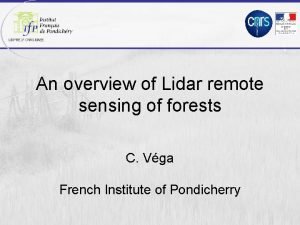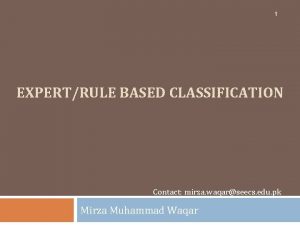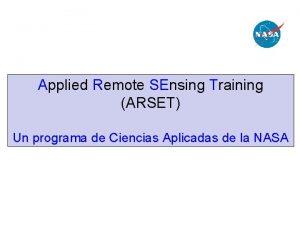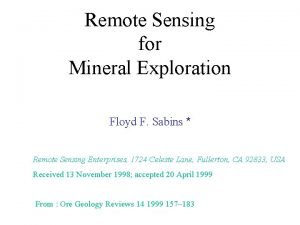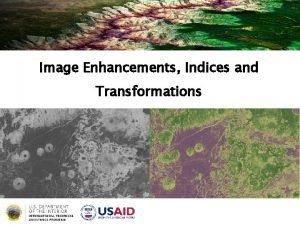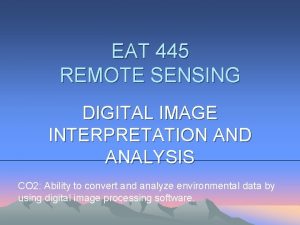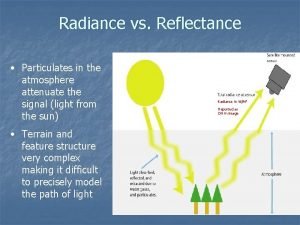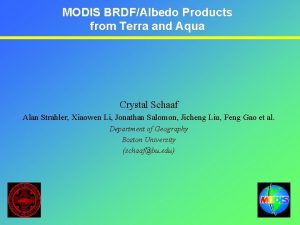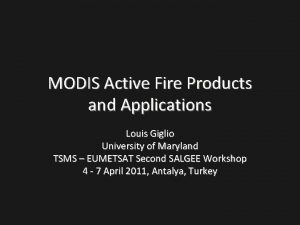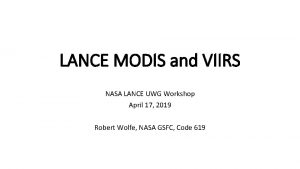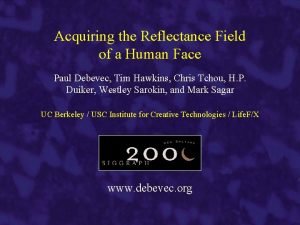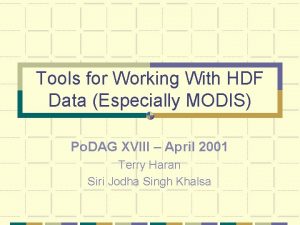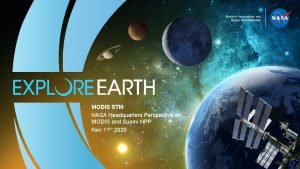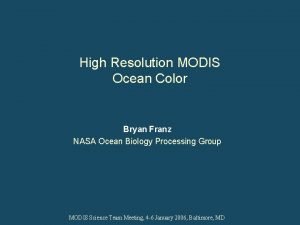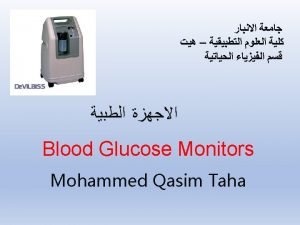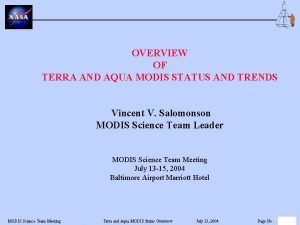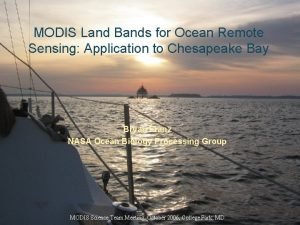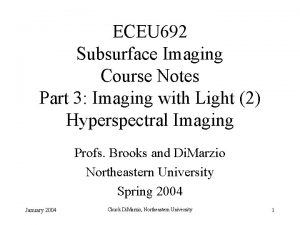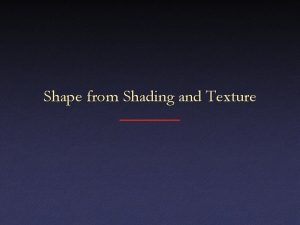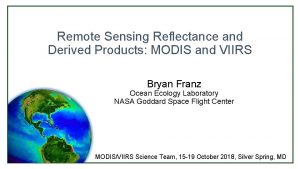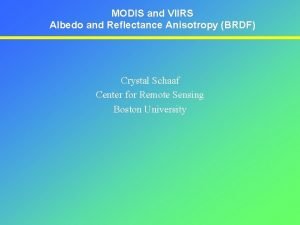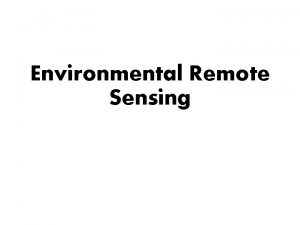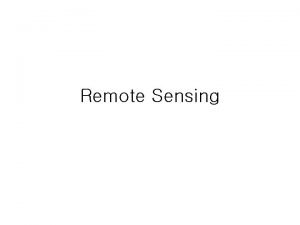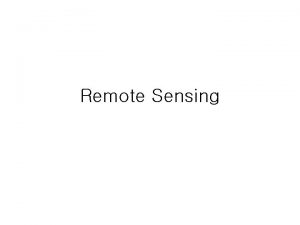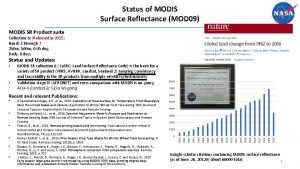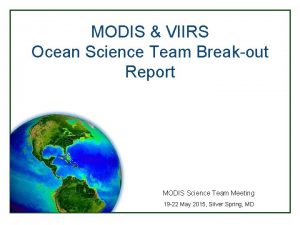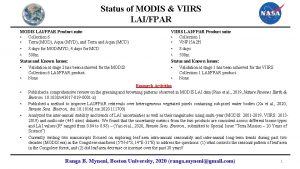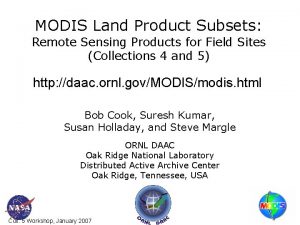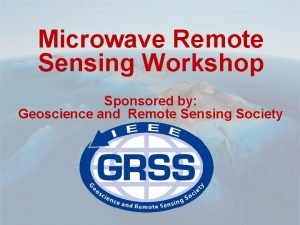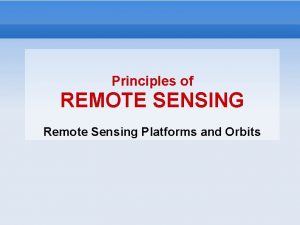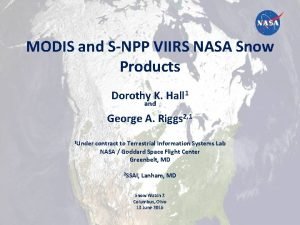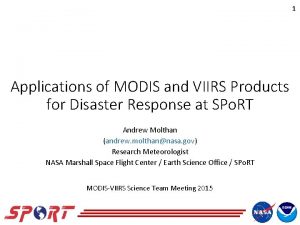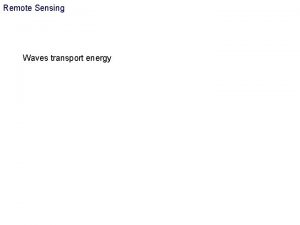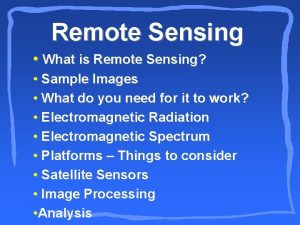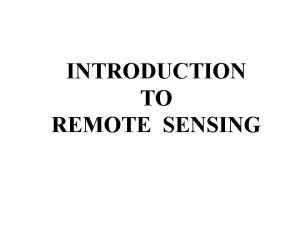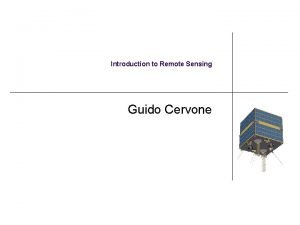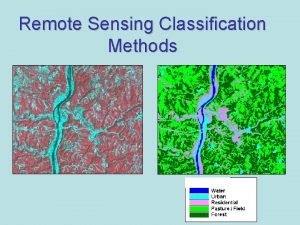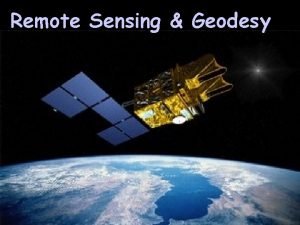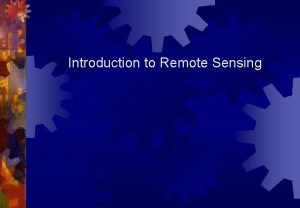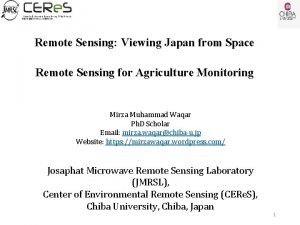Remote Sensing Reflectance and Derived Products MODIS VIIRS













































- Slides: 45

Remote Sensing Reflectance and Derived Products: MODIS & VIIRS Bryan Franz Ocean Ecology Laboratory NASA Goddard Space Flight Center MODIS/VIIRS Science Team Meeting 6 -10 June 2016, Silver Spring, MD

Definition Remote Sensing Reflectance, Rrs( ; sr-1), is water-leaving radiance, Lw( ), corrected for bidirectional effects of the air-sea interface and sub-surface light field, and normalized by downwelling solar irradiance, Ed( ), just above the sea surface. Rrs( ) is the fundamental measurement from which ocean color (OC) products such as phytoplankton chlorophyll concentration and marine inherent optical properties are derived. Primary purpose of our work is to develop a stable and consistent, long-term OC time-series spanning multiple mission lifetimes to support global change research and applications.

Proposal Team: MODIS & VIIRS Team Member Primary Role Bryan Franz project lead & quality assessment Zia Ahmad atmospheric correction Sean Bailey vicarious calibration & software Gene Eplee VIIRS calibration Gerhard Meister MODIS calibration Chris Proctor in situ validation Kevin Turpie VIIRS prelaunch Jeremy Werdell bio-optical algorithms and the Ocean Biology Processing Group. . .

Contents 1. MODIS & VIIRS OC Reprocessing Overview 2. Multi-mission OC Time-series Consistency 3. Product Validation and Uncertainties 4. Chlorophyll Climate Data Record 5. Summary

R 2014. 0 Multi-Mission Ocean Color Reprocessing Scope • CZCS, OCTS, Sea. Wi. FS, MERIS, MODIS(A/T), and VIIRS Motivation 1. improve interoperability and sustainability of the product suite by adopting modern data formats, standards, and conventions (net. CDF 4, CF and ISO conventions, etc. ) 2. incorporate algorithm updates and advances from community and science teams 3. incorporate knowledge gained in instrument-specific radiometric calibration and updates to vicarious calibration Status • CZCS, OCTS, VIIRS, MODISA, MODIST, Sea. Wi. FS (& GOCI) done • MERIS in progress 5

PRODUCT AND ALGORITHM CHANGES Rrs( ) Ångstrom calibration updates, ancillary data updates, improved land/water masking, terrain height, other minor fixes AOT Chlorophyll a Kd(490) standard chlor_a product now OCI algorithm (Hu et al. 2012) original OC 3/OC 4 product still being distributed as chl_ocx no change POC no change PIC updated algorithm and LUT CDOM_index remove product (redundant with new IOP suite) PAR consolidated algorithm, minor fixes i. PAR MODIS-only, no change n. FLH MODIS-only, flagging changes (allow negatives) IOPs added suite of inherent optical properties (Werdell et al. 2013)

INSTRUMENT CALIBRATION CHANGES Sea. Wi. FS • correcting dark offset changes at the sub-count level • correction for time-dependent change in system spectral response • Patt et al. (in prep), Eplee et al. (in prep) MODISA • • • MODIST VIIRS • • • updated temporal calibration from MCST (V 6. 1. 35. 17_OC 2) updated temporal corrections to response versus scan angle Meister and Franz 2014. updated temporal calibration from MCST (V 6. 1. 20. 16) updated temporal corrections for response versus scan angle and polarization sensitivity (crosscal to Sea. Wi. FS and MODISA) first use of lunar calibration trends to track temporal degradation of VIIRS (lunar calibration is used to correct more frequent but more uncertain solar calibration trends). correction of the lunar trends. NASA-developed for time-dependent changes Reprocessed tocalibration utilize new 6 in-minute spectral response of theand primary mirror. granule format Level-1 A Level-1 B correction of solar calibration trends for a solar unit vector error in and calibration code. (R 2014. 0. 2) the source data used for solar calibration analysis, and improved solar diffuser stability corrections. additional statistical correction for detector striping. Eplee et al. 2015

Contents 1. MODIS & VIIRS OC Reprocessing Overview 2. Multi-mission OC Time-series Consistency 3. Product Validation and Uncertainties 4. Chlorophyll Climate Data Record and Application 5. Summary

Sea. Wi. FS & MODISA Rrs( ) Deep-Water Time-Series showing good agreement R 2014. 0 412 443 490 -488 Sea. Wi. FS = solid line MODISA = dashed line Mean Ratio 1. 01 0. 99 1. 01 547 -555 9

MODIST & MODISA Rrs( ) Deep-Water Time-Series showing “mostly” good agreement R 2014. 0 412 MODISA = solid line MODIST = dashed line Mean Ratio 0. 99 443 0. 99 488 0. 99 531 10

MODISA & VIIRS Rrs( ) Deep-Water Time-Series showing “mostly” good agreement R 2014. 0 410 -412 443 486 -488 MODISA = solid line VIIRSN = dashed line suspect decline in MODISA Rrs(412) Mean Ratio 1. 04 0. 99 1. 02 547 -551 11

MODISA and VIIRS R 2014. 0 Chlorophyll Deep-Water Time-Series Mean Stdv MODISA 0. 197 0. 019 mg m-3 VIIRS 0. 177 0. 009 mg m-3 VIIRS/MODISA 0. 90 0. 06 MODISA VIIRS degraded confidence in MODISA trends 12

MODISA and VIIRS R 2014. 0 Chlorophyll Clear-Water Time-Series OCI algorithm yields higher values of chlorophyll in clear water relative to OCx (+0. 01 to 0. 015 mg m-3), with much improved consistency between sensors. OCI OCx Mean Stdv MODISA 0. 070 0. 008 mg m-3 VIIRS 0. 069 0. 007 mg m-3 VIIRS/MODISA 0. 98 0. 04 13

Sea. Wi. FS and MODISA R 2014. 0 Chlorophyll Clear-Water Time-Series OCI algorithm yields higher values of chlorophyll in clear water relative to OCx (+0. 005 to 0. 01 mg m-3), with improved consistency between sensors. OCI OCx Mean Stdv MODISA 0. 067 0. 006 mg m-3 Sea. Wi. FS 0. 067 0. 006 mg m-3 MODIS/Sea. Wi. FS 0. 992 0. 025 14

Seasonal Chlorophyll Comparison (2005) Fall Spring Sea. Wi. FS MODISA

Seasonal Chlorophyll Comparison (2015) Fall Spring MODISA VIIRS

Contents 1. MODIS & VIIRS OC Reprocessing Overview 2. Multi-mission OC Time-series Consistency 3. Product Validation and Uncertainties 4. Chlorophyll Climate Data Record and Application 5. Summary

Sea. Wi. FS VIIRS Satellite Chla (mg m-3) MODISA In situ Chla COUNT SLOPE INT (mg m-3) Sea. Wi. FS MODISA VIIRS 1739 653 21 0. 92 1. 04 0. 63 0. 02513 0. 07814 -0. 27375 0. 83 0. 80 0. 27 1. 07 1. 19 0. 86 37. 3 40. 7 34. 9 0. 29030 0. 30814 0. 27166 Sea. Wi. FS MODISA VIIRS 363 113 17 0. 83 0. 87 0. 50 -0. 09787 -0. 10674 -0. 37107 0. 74 0. 85 0. 30 1. 01 0. 97 0. 79 32. 4 22. 5 40. 9 0. 24365 0. 19605 0. 29676 Chlorophyll a Deep All PRODUCT R 2 MED RATIO APD (%) RMSE (mg m-3)

MODISA VIIRS Satellite Rrs (55 x; sr-1) Satellite Rrs (443; sr-1) Sea. Wi. FS In situ Rrs( ) Comparison between R 2014. 0 satellite retrievals and in situ measurements for Rrs at 443 nm and near 550 nm. Match-up is for all available in situ data from Sea. BASS and AERONET-OC.

MODIST vs MODISA MODIST Rrs(547) Satellite Rrs (547; sr-1) MODIST Rrs(443) Satellite Rrs (443; sr-1) MODISA In situ Rrs( ) MODISA Rrs( ) Comparison between R 2014. 0 satellite retrievals and in situ measurements for Rrs at 443 nm and near 547 nm. Match-up is for all available in situ data from Sea. BASS and AERONET-OC.

Developing per-pixel Rrs( ) uncertainty estimates instrument noise propagated through atmospheric correction via Monte Carlo simulation (MODIS-Aqua Ches. Bay, 1000 iterations) Rrs(443) Uncertainty Rrs(547) Uncertainty

Developing per-pixel chlorophyll uncertainty Chlorophyll Uncertainty

Contents 1. MODIS & VIIRS OC Reprocessing Overview 2. Multi-mission OC Time-series Consistency 3. Product Validation and Uncertainties 4. Chlorophyll Climate Data Record and Application 5. Summary

Chla (%) Chla (mg m-3) Long-term (18 -year) record of phytoplankton chlorophyll a for mid-latitude oceans (± 40⁰), constructed from R 2014. 0 MODISA VIIRS Multivariate Enso Index (MEI) Sea. Wi. FS MODISA VIIRS Chla Anomaly (%) Chla Anomaly (mg m-3) Sea. Wi. FS

Phytoplankton Chlorophyll decline in the Niño 3. 4 Region ~40% drop by December 2015 Solid lines MODIS/Aqua, dashed lines VIIRS/S-NPP, colors indicate different chlorophyll retrieval algorithms. NASA Ocean Biology Processing Group

2015 El Niño Anomaly (VIIRS) Image above shows mean phytoplankton chlorophyll distribution for 2015, from VIIRS processed by NASA. Images to right show change in chlorophyll in 2015 relative to the climatological norm, and correlated changes in sea surface temperature from MODIS on Aqua.

Summary • R 2014. 0 multi-mission ocean color reprocessing completed for VIIRS, MODIS/Aqua, and MODIS/Terra (& CZCS, OCTS, Sea. WIFS). • High degree of mission-to-mission consistency achieved for Rrs, with some exceptions in the blue (412 nm). • New OCI algorithm contributes to significant improvement in consistency of chlorophyll time-series for clearest ocean waters. • Validation of Rrs and Chl retrievals against in situ measurements shows equivalent performance for Sea. Wi. FS, MODIS, and VIIRS. • We have produced a long-term ocean color time-series of sufficient length (18 years), continuity, and consistency to assess climate-driven trends in ocean biology.

http: //soap. siteturbine. com/webbook/file. php? id=345

New on-line book: NASA Standard Atmospheric Correction Algorithm for Ocean Color Retrieval www. oceanopticsbook. info

Views of Our Planets” Forever stamps featuring iconic images of the planets in our solar system, including the well-known “Blue Marble” image of Earth. New “Pluto Explored” Views of Our Planets” Forever stamps featuring iconic images of the planets in our solar system, including the well-known “Blue Marble” image of Earth” were released on 31 May 2016 at the World Stamp Show in New York City, an international gathering of stamp collectors that occurs only once each decade in the U. S. with more than 250, 000 visitors attending.

Norman Kuring of the OBPG created the new “Blue Marble” using data taken by VIIRS on the NOAA/NASA Suomi NPP satellite soon after it began orbiting our home planet in 2011.

Questions?

MODISA & Sea. Wi. FS Rrs( ) Clear-Water Time-Series showing “good” agreement R 2014. 0 412 443 490 -488 Sea. Wi. FS = solid line MODISA = dashed line Mean Ratio 1. 01 1. 03 547 -555 33

MODIST & MODISA Rrs( ) Clear-Water Time-Series showing “good” agreement R 2014. 0 412 MODISA = solid line MODIST = dashed line Mean Ratio 0. 98 443 0. 98 488 0. 99 531 34

MODISA & VIIRS Rrs( ) Clear-Water Time-Series showing “good” agreement R 2014. 0 412 MODISA = solid line VIIRSN = dashed line Mean Ratio 1. 03 443 0. 98 486 -488 1. 02 547 -551 35

Rrs( ) Spectral Comparison common mission mean by water type Sea. Wi. FS and MODISA Sea. Wi. FS = filled circle MODISA = diamond Oligotrophic Mesotrophic MODISA and VIIRS MODISA = filled circle VIIRSN = diamond Eutrophic

Sea. Wi. FS and MODISA R 2014. 0 Chlorophyll Deep-Water Time-Series Mean Stdv Sea. Wi. FS 0. 183 0. 010 mg m-3 MODISA 0. 186 0. 013 mg m-3 MODIS/Sea. Wi. FS 1. 017 0. 036 MODISA VIIRSN Black Blue = solid line = dashed line = OCI algorithm = OCx algorithm 37

Algorithm

Remote Sensing Reflectance (Rrs; sr-1) Rrs is the ratio of upwelling “water-leaving” radiance to downwelling irradiance, just above the sea surface Atmospheric Correction Rrs is the fundamental remote sensing quantity from which most ocean color products are derived (e. g. , chlorophyll, particulate organic and inorganic carbon, inherent optical properties) s ob ed v er A O T h R g ei l ay ae ro l so + Ra a y- er a fo p ca s te m & i wh n Su in gl ng t e wa t -l er i av

determining aerosol contribution assume Lw( ) = 0 at two NIR (or SWIR) bands, or that it can be estimated with sufficient accuracy. retrieve aerosol reflectance in each NIR band as known use spectral dependence of retrieved NIR aerosol reflectance (e) to select the most appropriate aerosol model from a suite of pre-computed models use NIR aerosol reflectance and selected aerosol model to extrapolate aerosol reflectance to visible wavelengths 40

aerosol model tables Fine Mode Albedo • • • vector RT code (Ahmad-Fraser) based on AERONET size distributions & albedos 80 models (10 size fractions within 8 humidities) – 100% coarse mode to 95% fine mode – non- or weakly absorbing • LUT: extinction, albedo, phase function, ss->ms, td – function of path geometry (or scattering angle) • model selection discriminated by relative humidity Typical Size Distributions Mean AERONET Fine & Coarse Modal Radii Rh 0. 30 0. 50 0. 75 0. 80 0. 85 0. 90 0. 95 rvf 0. 150 0. 152 0. 158 0. 167 0. 187 0. 204 0. 221 0. 246 σf 0. 437 0. 437 rvc 2. 441 2. 477 2. 927 3. 481 3. 966 4. 243 4. 638 5. 549 σc 0. 672 0. 672 rvf/rovf 1. 006 1. 019 1. 063 1. 118 1. 255 1. 371 1. 486 1. 648 rvc/rovc 1. 009 1. 024 1. 210 1. 439 1. 639 1. 753 1. 917 2. 293 Ahmad et al. 2010, Appl. Opt.

aerosol model selection & application select the two sets of 10 models (10 size fractions) with relative humidity (RH) that bound the RH of the observation. find the two models that bound the observed epsilon within each RH model family. * model epsilon use model epsilon to extrapolate to visible. compute weighted average, , between models within each RH family, and then again between bounding RH solutions. 42 *actually done in single scattering space and transformed to multi-scattering

we estimate Lw(NIR) using a bio-optical model guess Lw(670) = 0 model 1) convert Lw(670) to bb/(a+bb) Lw(NIR) = func Lw(670) via Morel f/Q and retrieved Chla correct 2) estimate a(670) = aw(670) + apg(670) L'a(NIR) = La(NIR) – t Lw(NIR) via NOMAD empirical relationship retrieve 3) estimate bbp(NIR) = bbp(670) ( /670)h Liw(670) test |Lwi+1 (670) - Liw(670)| < 2% done via Lee et al. 2002 no 4) assume a(NIR) = aw(NIR) 5) estimate Lw(NIR) from bb/(a+bb) via Morel f/Q and retrieved Chla Bailey et al. , Optics Express, 2010

brdf correction to account for shape of sub-surface light-field due to position of the Sun and optical properties of the water column. based on pre-computed look-up tables from hydrolight simulations of Morel et al. 2002, Appl. Opt. given radiant path geometry (θ 0, θ , Dj), windspeed (w) and Chl = f (R’rs( )) θ 0=0, θ =0, Dj=0 iteration fb( , θ 0, θ , Dj, Chl, w) = (R 0 f 0/Q 0) / (R f/Q) f/Q relates subsurface irradiance reflectance to radiance reflectance R includes all reflection/refraction effects of the air-sea interface Rrs( ) = R’rs( ) fb( , θ 0, θ , Dj, Chl, w) Chl = f (Rrs( ))

adaptation to VIIRS • standard MODIS atmospheric correction software was modified (previous S-NPP science team) to also process VIIRS • starts from VIIRS pseudo Level-1 A, and applies instrument calibration in Level-1 A to Level-2 – Level-1 A developed by multi-disciplinary NASA team – instrument calibration developed by OBPG (Eplee et al. 2015) • algorithm modifications limited to adjustment for sensor-specific spectral band centers and relative spectral responses • same Ahmad-Fraser vector radiative transfer code used to derive MODIS & VIIRS-specific Rayleigh and aerosol model tables • bands used for aerosol determination – MODIS: 748 & 869 nm – VIIRS: 745 & 862 nm
 Ifov and fov in remote sensing
Ifov and fov in remote sensing National authority for remote sensing and space sciences
National authority for remote sensing and space sciences Energy transfer
Energy transfer Remote sensing platforms
Remote sensing platforms Active passive remote sensing
Active passive remote sensing Advantages of remote sensing
Advantages of remote sensing Digital number remote sensing
Digital number remote sensing Limitations of remote sensing
Limitations of remote sensing Idealized remote sensing system
Idealized remote sensing system Gis definition ap human geography
Gis definition ap human geography Remote sensing
Remote sensing Parallax in remote sensing
Parallax in remote sensing Strip camera in remote sensing
Strip camera in remote sensing Remote sensing image
Remote sensing image Fiducial axis in aerial photography
Fiducial axis in aerial photography Canada centre for remote sensing
Canada centre for remote sensing What is placelessness in ap human geography
What is placelessness in ap human geography Remote sensing applications center
Remote sensing applications center Remote sensing applications center
Remote sensing applications center Remote sensing physics
Remote sensing physics Microwave remote sensing lecture notes
Microwave remote sensing lecture notes Remote sensing in precision agriculture
Remote sensing in precision agriculture Aerial photography in remote sensing pdf
Aerial photography in remote sensing pdf Introduction to microwave remote sensing
Introduction to microwave remote sensing Remote sensing physics
Remote sensing physics Geometric corrections
Geometric corrections Cegeg
Cegeg Lidar remote sensing for forestry
Lidar remote sensing for forestry Process
Process Applied remote sensing training program
Applied remote sensing training program Advantages of remote sensing
Advantages of remote sensing Remote sensing
Remote sensing Digital interpretation in remote sensing
Digital interpretation in remote sensing Reflectance vs radiance
Reflectance vs radiance Modis competence center
Modis competence center Giglio
Giglio Lance modis
Lance modis Acquiring the reflectance field of a human face
Acquiring the reflectance field of a human face Modis
Modis Stm nasa
Stm nasa Modis
Modis Reflectance photometry principle
Reflectance photometry principle Aqua terra modis
Aqua terra modis Modis bands
Modis bands Reflectance spectroscopy
Reflectance spectroscopy Lambertian reflectance
Lambertian reflectance
